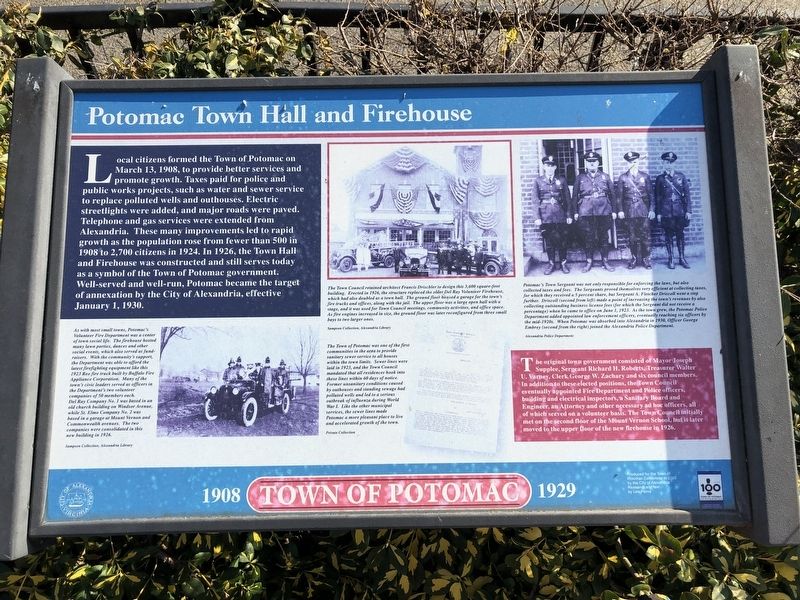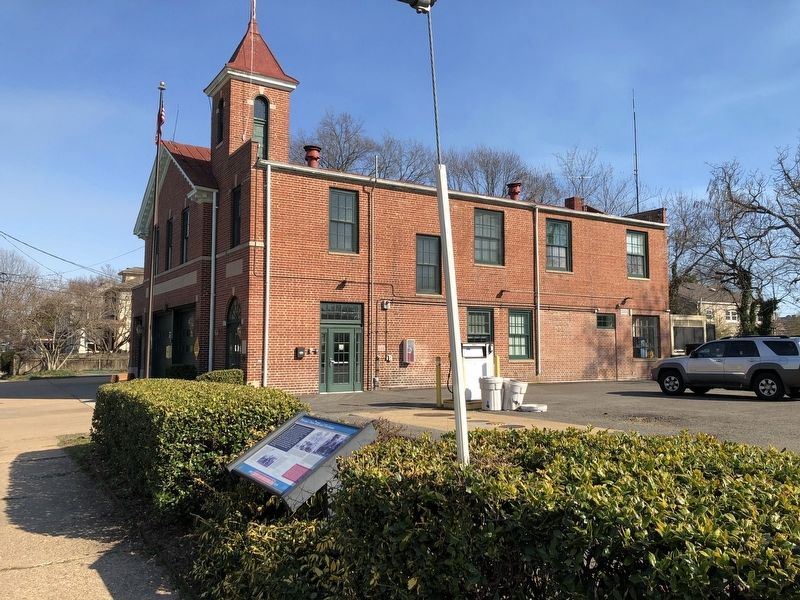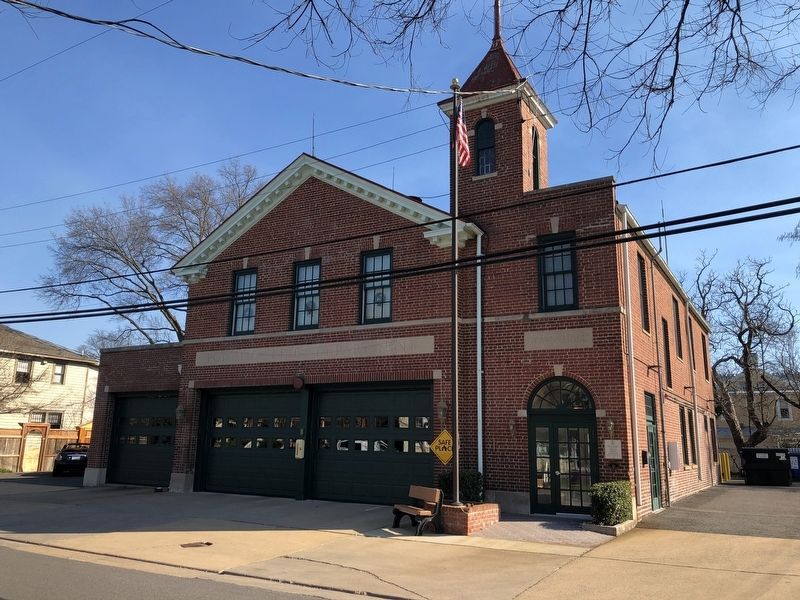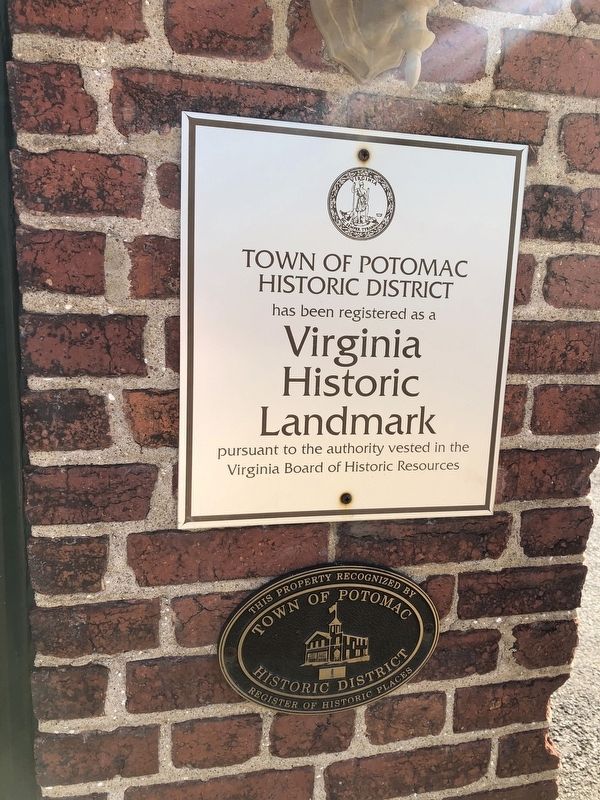Potomac West in Alexandria, Virginia — The American South (Mid-Atlantic)
Potomac Town Hall and Firehouse
Town of Potomac
— 1908 - 1929 —
Local citizens formed the Town of Potomac on March 13, 1908, to provide better services and promote growth. Taxes paid for police and public works projects, such as water and sewer service to replace polluted wells and outhouses. Electric streetlights were added, and major roads were paved. Telephone and gas services were extended from Alexandria. These many improvements led to rapid growth as the population rose from fewer than 500 in 1908 to 2,700 citizens in 1924. In 1926, the Town Hall and Firehouse was constructed and still serves today as a symbol of the Town of Potomac government. Well-served and well-run Potomac became the target of annexation by the City of Alexandria, effective January 1, 1930.
The original town government consisted of Mayor Joseph Supplee, Sergeant Richard H. Roberts, Treasurer Walter U. Varney, Clerk George W. Zachary and six council members. In addition to these elected positions, the Town Council eventually appointed Fire Department and Police officers, building and electrical inspectors, a Sanitary Board and Engineer, an Attorney and other necessary ad hoc officers all of which served on a volunteer basis. The Town Council initially met on the second floor of the Mount Vernon School, but it later moved to the upper floor of the new firehouse in 1926.
[Captions:]
The Town Council retained architect Francis Drischler to design this 3,600 square-foot building. Erected in 1926, the structure replaced the older Del Ray Volunteer Firehouse which had also doubled as a town hall. The ground floor housed a garage for the town's fire trucks and offices, along with the jail. The upper floor was a large open hall with a stage, and it was used for Town Council meetings, community activities, and office space. As fire engines increased in size, the ground floor was later reconfigured from three small bays to two larger ones.
Sampson Collection, Alexandria Library
Potomac's Town Sergeant was not only responsible for enforcing laws, but also collecting taxes and fees. The Sergeants proved themselves very efficient at collecting taxes, for which they received a 5 percent share, but Sergeant A. Fletcher Driscoll went a step further. Driscoll (second from left) made a point of increasing the town's revenues by also collecting outstanding business license fees (for which the Sergeant did not receive a percentage) when he came to office on June 1, 1923. As the town grew, the Potomac Police Department added appointed law enforcement officers, eventually reaching six officers by the mid-1920s. When Potomac was absorbed in 1930, Officer George Embrey (second from the right) joined the Alexandria Police Department.
Alexandria
As with most small towns, Potomac's Volunteer Fire Department was a center of town social life. The firehouse hosted many lawn parties, dances and other social events, which also served as fundraisers. With the community's support, the Department was able to afford the latest firefighting equipment like this 1923 Reo fire truck built by Buffalo Fire Appliance Corporation. Many of the town's civic leaders served as officers in the Department's two volunteer companies of 50 members each. Del Ray Company No. 1 was based in an old church building on Windsor Avenue, while St. Elmo Company No. 2 was based in a garage at Mount Vernon and Commonwealth avenues. The two companies were consolidated in this new building in 1926.
Sampson Collection, Alexandria Library
The Town of Potomac was one of the first communities in the area to provide sanitary sewer service to all houses, within the town limits. Sewer lines were laid in 1923, and the Town Council mandated that all residences hook into these lines within 60 days of notice. Former unsanitary conditions caused by outhouses and standing sewage had polluted wells and led to serious outbreak of influenza during World War I. Like the other municipal services, the sewer lines made Potomac a more pleasant place to live and accelerated growth of the town.
Private
Erected 2008 by City of Alexandria, Virginia.
Topics and series. This historical marker is listed in these topic lists: Charity & Public Work • Law Enforcement • Roads & Vehicles • Settlements & Settlers. In addition, it is included in the Virginia, The City of Alexandria series list. A significant historical date for this entry is January 1, 1930.
Location. 38° 49.481′ N, 77° 3.452′ W. Marker is in Alexandria, Virginia. It is in Potomac West. Marker is on East Windsor Avenue just east of Mt. Vernon Avenue, on the right when traveling east. Touch for map. Marker is at or near this postal address: 207 East Windsor Avenue, Alexandria VA 22301, United States of America. Touch for directions.
Other nearby markers. At least 8 other markers are within walking distance of this marker. The Town of Potomac / Mount Vernon Avenue (approx. 0.2 miles away); Universal Lodge No. 1 (approx. 0.2 miles away); Potomac Yard History (approx. 0.2 miles away); St. Asaph Racetrack (approx. 0.2 miles away); Corporal Charles William Hill (approx. 0.2 miles away); a different marker also named St. Asaph Racetrack (approx. 0.2 miles away); Schools in the Town of Potomac (approx. ¼ mile away); The Electric Railway (approx. 0.3 miles away). Touch for a list and map of all markers in Alexandria.
Credits. This page was last revised on January 27, 2023. It was originally submitted on March 9, 2020, by Devry Becker Jones of Washington, District of Columbia. This page has been viewed 229 times since then and 17 times this year. Photos: 1, 2, 3, 4. submitted on March 9, 2020, by Devry Becker Jones of Washington, District of Columbia.



